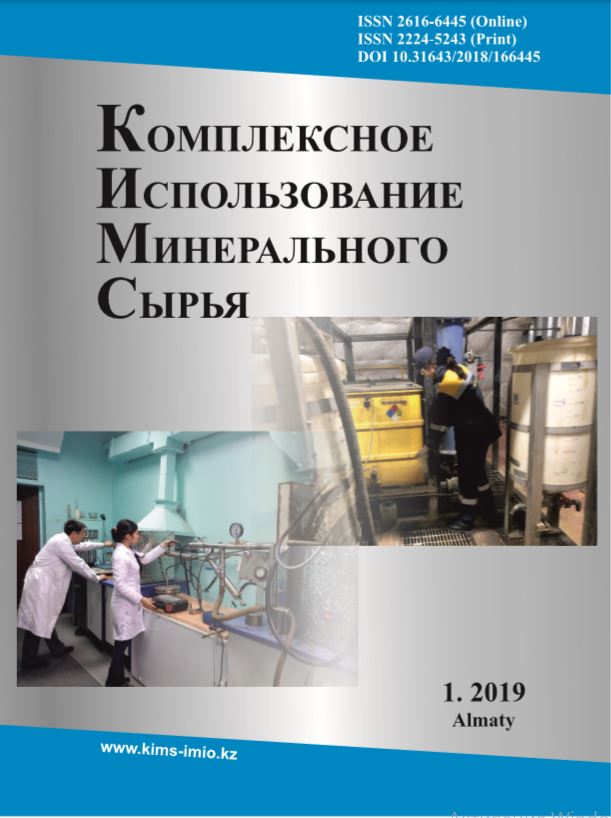Electrochemical processing of tin-containing solders with the use of electrolyte based on potassium hydroxide
DOI:
https://doi.org/10.31643/2019/6445.08Keywords:
lead-tin solders, alkaline electrolyte, anodic dissolution, electrochemical polarization.Abstract
This article is dedicated to the processing of the secondary tin-containing alloys by the electrochemical method. The provided article reviews exploratory studies regarding the anodic dissolution of the lead-tin solders, conducted by the EСС-1012 electrochemical complex in galvanostatic mode with using as an electrolyte solution of potassium hydroxide. The anodic dissolution was demonstrated to go differently depending on the concentration of alkaline electrolyte. For instance, at 50 g/dm3 concentration of potassium hydroxide, the dissolution commence was recorded at a 0.4 V capacity and the reaction goes predominantly with the HSnO2– formation, also in this case the lead dissolution is unlikely. After that, the anode passivation takes place owing to the formation of oxidation films of the metals and oxygen release. The alkali concentration increases within the electrolyte to 100 g/dm3 leads to a dramatic change in the current potential curves, corresponding to the formation of HSnO2-, HPbO2-, Sn2+ and Pb2+. In addition, an increase of alkali concentration in the solution will contribute to a more active dissolution of the metals, even at the initial stage. As the anode surface develops, it beneficiates alternately with either lead or tin. The formation of tetravalent lead and tin ions upon anodic dissolution of lead-tin alloys in the alkali solutions is unlikely. Within the process of anodic dissolution, an electrolytic sludge was obtained, which contained not only a tin but also the copper, lead, antimony, aluminum and iron have been found.
Downloads
References
Kolodin S.M. Vtorichnoye olovo i pererabotka bednogo olovyannogo syr'ya.(Secondary tin and processing of poor tin raw materials) Moscow: Metallurgy, 1970. 240. (in Russ).
Rossoshinskiy A.A., Lapshov YU.K., Yatsenko B.P. Olovo v protsessakh payki.(Tin in the process of soldering.)Kiyev: Naukova dumka, 1985. 197. (in Russ).
Shubov L.YA., Stavronskiy M.Ye., Shekhirev D.V. Tekhnologii otkhodov (Tekhnologicheskiye protsessy v servise)Waste technologies (Technological processes in service): Tutorial. Moscow: State Educational Institution of Higher Professional Education “MGUS”,2006. 411. (in Russ).
Fetisov G.P. Materialovedeniye i tekhnologiya metallov:(Materials science and technology of metals)Textbook. Moscow: Higher School, 2006. 862. (in Russ).
Kupryakov YU.P. Proizvodstvo tyazhelykh tsvetnykh metallov iz loma i otkhodov.(Production of non-ferrous metals from scrap and waste). Kharkov: Basis, 1992.399. (in Russ).
Khudyakov I.F., Doroshkevich A.P., Karelov S.V. Metallurgiya vtorichnykh tsvetnykh metallov. (Metallurgy secondarynon-ferrous metals)Moscow: Metallurgy, 1987. 528. (in Russ).
Pat. RU22245935 (RF). Sposob izvlecheniya olova iz otkhodov.(The method of extraction of tin from waste) E.P. Buchikhin, A.Yu. Kuznetsov, V.V. Shatalov. -Electronic resource on the site:http://www.findpatent.ru/patent/224/2245935.html(in Russ).
Pat. RU2230126 (RF). Sposob regeneratsii olovyanno-svintsovogo pripoya.(The method of regeneration of tin-lead solder). A.N. Parfenov. -Electronic resource on the site:http://www.findpatent.ru/patent/223/2230126.html(in Russ).
Manis Kumar Jha, Pankaj Kumar Chjubley, Amrita Kumari Jha, Archanakumari, Jae-chun Lee, Vinay Kumar, Jinki Jeong. Leaching studies for tin recovery from waste e-scrap.Waste management. 2012. 32.1919-1925. https://doi.org/10.1016/j.wasman.2012.05.006(in Eng).
Pat. RU2625156 (RF). Sposob izvlecheniya olova iz otkhodov elektronnoy i elektrotekhnicheskoy promyshlennosti.(Themethod of extraction of tin from waste electronic and electrical industries)A.P. Denisenko, M.A. Luchko, S.A. Redkin, L.A. Shtoda, K.A. Krivulko, M.V. Semin, V.B. Salov, E.V. Cherkasov, N.I. Bezzubov. Without teeth. -Electronic resource on the site: http://www.findpatent.ru/patent/262/2625156.html(in Russ).
Tianxiang Nan, Jianguangyang, Bing Chen. Electrochemical mechanism of tin membrane electrode position under ultrasonic waves.Ultrasonics Sonochemistry. 2018. 42. 731-737. https://doi.org/10.1016/j.ultsonch.2017.12.044(in Eng).
Yang Jian-guang, Lei Jie, Peng Si-yao, Lv Yuan-lu, Shi Wei-qiang. A new membrane electro-deposition based process for tin recovery from waste printed circuit boards.Journal of Hazardours Materials. 2016.304.409-416. https://doi.org/10.1016/j.jhazmat.2015.11.007(in Eng).
Karelov S.V., Mamyachenkov S.V.,Kirpikov A.S., Anisimova O.S. Issledovaniye elektroliticheskogo rafinirovaniya svintsovo-olovyannykh splavov vo ftoristovodorodnykh elektrolitakh.(Investigation of electrolytic refining of lead-tin alloys in hydrofluoric electrolytes) Non-ferrous metals=Tsvetnyye metally. 2004. 4. 41-45. (in Russ).
Bol'shakov K.A., Fedorov P.I. Khimiya i tekhnologiya malykh metallov: (Chemistry and technology of small metals)a textbook. M.: MIHM, 1984. 86. (in Russ).
Tur'yan YA.I. Okislitel'no-vosstanovitel'nyye reaktsii i potentsialy v analiticheskoy khimii.(Oxidation-reduction reactions and potentials in analytical chemistry) M.: Chemistry,1989. 248.(in Russ).
Kenzhaliev B. Electrochemical Method for Extracting Non-Ferrous and Precious Metals from Refractory Materials Using Combined Reactions. Book of Abstracts of the 15th Topical Meeting of the International Society of Electrochemistry, Interfacial Electrochemistry at Atomic, Molecular and Nanoscale Domains. 27-30 April 2014. Niagara Falls, Canada, page 98.(in Eng).
Beissembetov I.K., Bekibayev T.T., Zhapbasbayev U.K., Makhmotov Ye.S., Kenzhaliyev B.K.(2016). Upravleniye energosberegayushchimi rezhimami transportirovki neftesmesey.(Management of energy-saving modes of transportation of oil mixtures)https://doi.org/10.31643/2016-2019.001(in Russ).
Kenzhaliev B.K., SuleimenovE.N. Effects of Electric Current Parameters on Metals Solubility in Inorganic Water Solutions. 11th Spring Meeting of the International Society of Electrochemistry. USA. Theoretical and Computational Electrochemistry. 21-23 May, 2012, 105.(in Eng).
Yergozhin Ye.Ye., Kenzhaliyev B.K., Chalov T.K., Akhmetova K.SH., Kovrigina T.V. Vysokopronitsayemyye polielektrolity dlya izvlecheniya ionov zolota i soputstvuyushchikh metallov iz tsianistykh rastvorov kuchnogo vyshchelachivaniya. (Highly permeable polyelectrolytes for the extraction of gold ions and related metals from cyanide heap leaching solutions). Tsvetnyye metally=Non-ferrous metals, 2005. 43-46.(in Russ).
Downloads
Published
How to Cite
Issue
Section
License
Copyright (c) 2019 Akbarov, M., Chernyshova, O., Ussoltseva, G., & Akchil, А.

This work is licensed under a Creative Commons Attribution-NonCommercial-NoDerivatives 3.0 Unported License.


























